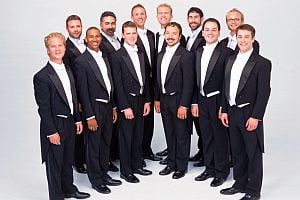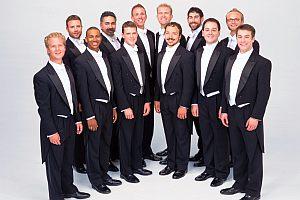
Chanticleer’s acclaimed sound was in abundance Sunday, with clean, pure intonation; mellifluous phrases; and unfailingly impeccable, beautiful cadences. The 12 singers were visibly attuned to each other, and sang with an ease born of a comfort both with their fellow performers and with the musical style. Their passion for this music, and their joy in performing it, were obvious.
Lasso’s music is glorious, and the three pieces Chanticleer presented displayed richly contrasted aspects of his compositional art. The six-voiced Missa Tous les regretz is based on a motet by the earlier composer Nicholas Gombert. The ensemble seamlessly transitioned from the motet into the “Kyrie” of the Mass, in which Lasso makes prominent use of his model. The chanted sections of the “Kyrie” were elaborate, and sung in perfect unison. The mood created was contemplative, slightly serious, and yet hopeful.
Anyone expecting this mood to prevail in the “Gloria,” however, was in for a surprise. Both the “Gloria” and the “Credo” were briskly sung, featuring rhythmic vitality and ornamental flourishes. Apart from startlingly jaunty hosannas, the “Sanctus” and “Agnus Dei” returned to the mood of the “Kyrie.” The unexpected softness Chanticleer used in the final “Agnus” was an ideal reflection of the poignancy of Gombert’s chanson as well as the plea for mercy in the Mass text.
I found Chanticleer’s tempos in the fast movements engaging, but not completely convincing, as the filigreed ornamental passages went by so quickly as to leave mere impressions rather than glittering cascades beckoning the ear to follow. I also felt that the blend suffered in parts of the Mass where the sopranos sang in a high register; they lacked a core to their sound, making them sound untethered to the rest of the group.
Rich Sonorities
The Miserere mei, Deus, drawn from Lasso’s set of Penitential Psalm settings, was presented as an intimate work. Scored for five voices in predominantly lower ranges, it also is less busy than the Mass, drawing the listener into a richly sonorous realm, rather than toward a peripatetic melody. Chanticleer’s approach to this challenge was to make the most of the sonority, rather than to draw the listener along through the passion of the psalm text. The group seemed to choose an overall affect for the entire piece — as it had done with each main mass section — and, with isolated exceptions, it did not break the mold until the next piece.Although Lasso’s setting does not allow for dramatically varied tempos, I waited to hear more give-and-take in the phrasing, more emphasis on notable words, more dynamics throughout the work. Chanticleer produced lovely, even luscious sounds, yet those sounds on the whole remained, unfortunately, emotionally unevocative.
This all changed with the final piece, Laudate Dominum de caelis, Lasso’s setting of texts from Psalms 148 and 150, which concludes his Penitential Psalms manuscript. From its first moments, this piece exuded energy and joy. Chanticleer seized its opportunities for word-painting, and made these psalm texts sparkle with drama and life. Apart from the Laudate, I found the most emotionally convincing moments of the evening to be in the duos, trios, and quartets that appeared sparingly amid the more full-voiced texture. These passages, whether sung with just one voice per part or with two, always seemed to offer an intimacy and earnestness that wasn’t as apparent when the entire group sang together. The “Crucifixus” and “Benedictus” sections of the Mass, and the verses “Auditi meo dabis gaudium” and “Quoniam si voluisses sacrificium” of Psalm 51, were particularly compelling. I only wished the full ensemble sections had displayed the same emotional depths as these intimate moments.

